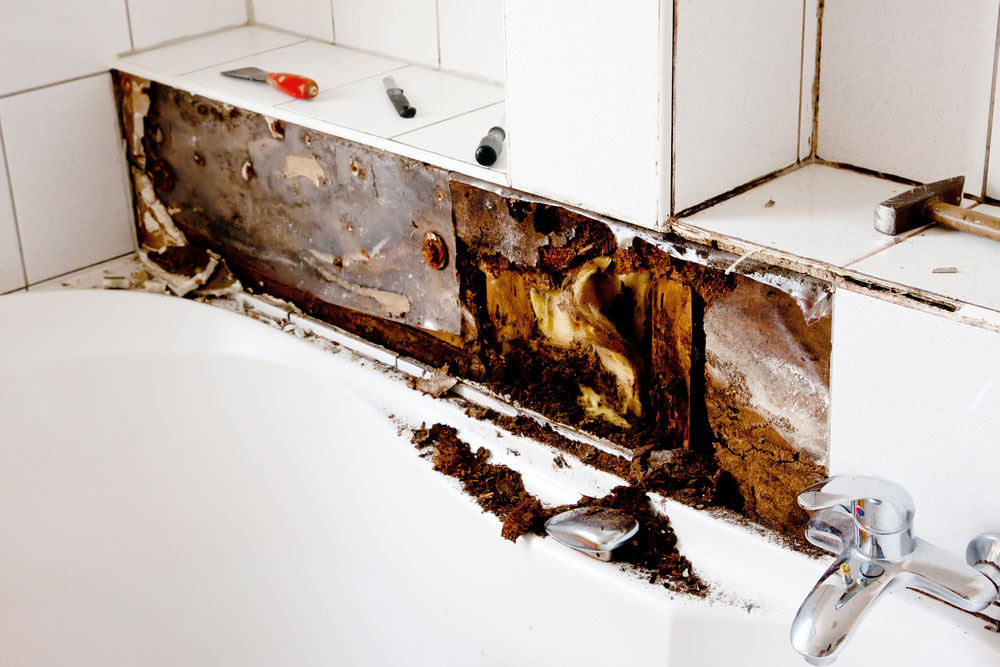How do you really feel in relation to Common Causes of Water Damage in a Bathroom?

The restroom is extremely prone for moist buildup as well as possible water damage because of the constant use of water in it. This article provides easy examination methods to aid discovering water damages risks.
The constant use of water in the washroom makes it incredibly at risk for moist buildup and prospective water damage. By examining it regularly, you can decrease water relevant damages.
The complying with collection of evaluations is simple to perform and must be done as soon as in every three months in order to maintain your bathroom in good shape as well as to prevent prospective water problems brought on by the bathtub, the shower, pipeline joints and also plumbing, sinks, cabinets, as well as the commode
Do not neglect carrying out these examinations and be comprehensive while doing them. Remember that these simple evaluations can conserve you a great deal of cash by providing early indicators for water damages
Bathtub and Shower
The shower as well as tub call for unique attention and maintenance. Inspect the floor tiles and replace if fractured. See to it that there is no missing grout between the ceramic tiles. Check and also change cracked caulking at joints where the walls meet the floor or the tub. Blocked drains pipes and also pipelines troubles will certainly prevent the bathtub from drying and may indicate major issues underneath the tub. Talk to a specialist quickly to stop architectural damages. Take notice of stainings or soft locations around the bath tub wall surfaces as they might show an interior leakage.
Plumbing
Signs for water damage are difficult to discover considering that a lot of pipes are set up inside the walls.
Pay unique focus to floor covering and also wall surfaces wetness as well as spots as they may indicate an undetectable plumbing problem. Check moisture degrees in adjacent spaces also.
Sinks and Cabinets
Sinks and cabinets are revealed to dampness as well as humidity daily and are usually forgotten. Examine frequently under the sink and on the countertop over it. Fix any drip in the trap as it might recommend drain problems. Look around the sink, sluggish draining pipes may show an obstructed drain. Change sink seals if they are split or loose.
The Toilet
The commode is a prone water junction. Examine the water lines and also search for leaks around the toilet seat, in the hose, and also under the water storage tank. If you detect any kind of indications of moisture on the flooring around the bathroom, check for leakages in the toilet rim and also storage tank seals.
Be aware that hanging commode bowl deodorants boosts the possibilities for obstructions.
TIPS TO PREVENT WATER DAMAGE IN THE BATHROOM
The average household uses approximately 80-100 gallons of water per person per day. For a family of 4, that's almost 2,500 gallons of water a week! The largest portion of this consumption comes from bathroom use. Flushing the toilet uses the most water, followed by taking a shower or bath. With that much water running through the home, water damage in the bathroom is bound to happen. Knowing how to spot signs of a water leak is essential to preventing long-term damage. This guide provides you with tips to reduce the impact of water damage on your bathroom.
CAUSES OF BATHROOM WATER DAMAGE
Pipe breaks are the most common cause of water damage we see in our daily jobs. The age of a pipe plays a large role in a pipe break as well as corrosion. Over time, the metal begins to break down, allowing water to escape. Frozen pipe breaks are also a concern in the winter months. Toilet overflows caused by paper products or children flushing inappropriate items. Degraded caulking around the toilet or bathtub can allow water seepage, sometimes behind the fixture, into the subfloor or walls. Condensation forms when the water in a pipe is cooler than the air temperature. Beads of water form on the exterior of the pipes, sometimes so much so that the water begins to drip and pool below. Sink or shower backups created by poor drainage. HOW TO PREVENT WATER DAMAGE IN YOUR BATHROOM
Inspect your toilet supply line for worn or frayed hoses and replace them as needed. Winterize your plumbing to prevent a frozen pipe break. Use vent fans to prevent condensation that can lead to mold growth. Routinely check and replace degraded caulking around your toilet or bathtub. Increase the temperature in your toilet tank and insulate your pipes during the warm summer months to keep condensation from forming. Use child safety locks on the toilets. Flush only toilet paper. "Flushable" wet wipes are actually not good for your plumbing system. Additionally, feminine hygiene products should not be flushed. Prevent water from escaping the tub or shower. Make sure shower curtains are in good condition. Inspect shower doors and replace the seal strip if necessary. Wipe up any water that accumulates on the floor and use bath mats. Water left to sit can cause damage to the tiles and flooring. Refrain from using bath products containing heavy oils to avoid a clogged drain.

Hopefully you liked our post about How to Repair and Prevent Bathroom Water Damage. Thanks a ton for spending some time to read our piece of content. Make sure you take the time to share this article if you enjoyed reading it. Thanks a lot for your time. Come back soon.
Hire A Pro